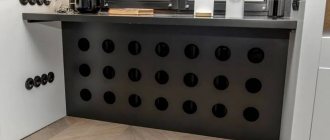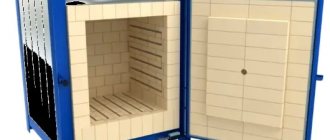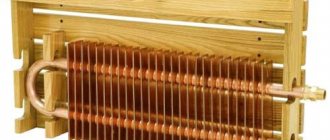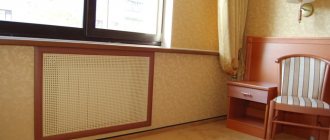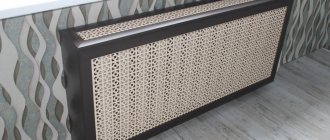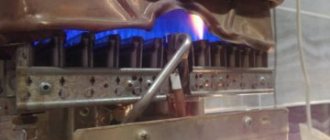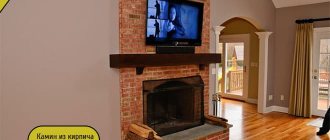Decorative grilles for heating radiators have become widespread. A wide range of models, differing in design, color, material of manufacture, method of fixation, fit harmoniously into any interior - from classic to modern. At the same time, the products perform the main function - they do not interfere with the effective heating of the living space.
Overlay facade on a heating radiator
Why do you need a battery screen?
A correctly chosen decorative screen will not only disguise the unpresentable appearance of the radiator, but will become a natural addition to the interior, emphasizing its style and color scheme.
Plastic screen in a modern style
There are several functions that radiator screens perform:
- Being a technical device with protruding elements - sharp edges, taps, valves, the heating radiator carries some danger. It is also worth considering that sometimes the surface temperature of the battery is quite high and touching it can cause a burn. Therefore, the screen performs a protective function . This is especially true in families with small children.
- Due to the correct choice of material for making the product, optimal selection of the location and size of the holes, it is possible to improve the convection of the battery and increase the efficiency of the heating process . For example, using a metal screen model you can increase the heating area.
- The decorative possibilities of the radiator screen are obvious - the battery does not always look appropriate in the interior. With its appearance, it can spoil the entire impression, “break” a finely calibrated and thoughtful design concept. The overlay, made in the same style as the interior, will fit organically into it and will not stand out from the general background.
- Due to their design, old-style batteries are most susceptible to rapid contamination of hard-to-reach places where dust and debris accumulate. It takes a lot of time and effort to keep such a structure perfectly clean. With the help of the screen, the issue of cleanliness is solved radically - the battery is reliably protected from contamination , and the screen itself does not require complex care and always looks neat.
The perforation pattern is selected taking into account the design style of the room
How to remove the radiator grille of Renault Sandero
Protective mesh for radiator grille
The radiator grille is designed to protect the radiator itself from mechanical damage when the car is moving. When driving on any road, there is always a chance that a stone or other object will fly out from under the wheels of the car in front and hit the radiator. In order to protect the unit from mechanical damage, you can install a mesh behind the plastic.
There are several ways to remove the radiator grille on a Renault Sandero. Any of them will take some time and require a specific tool.
Without dismantling
You need to start by unscrewing several screws that secure the lower part of the bumper to the Sandero body. This will loosen the tension, making it easier to remove the radiator grille. This is done using Torx screws. Self-tapping screws have a six-point head. You won’t be able to unscrew them with a simple Phillips screwdriver, so it’s better to stock up on the right tool.
After unscrewing the screws, the tool will no longer be needed. The remaining procedures are carried out manually. As already mentioned, the plastic part itself is held in the bumper by latches. To dismantle it, you need to press each latch down and press the plastic itself inward. This way you can take him out of the holds one by one. We do the same with the remaining latches of the lower part.
Next, the plastic needs to be shifted to the right. At this stage it is necessary to act extremely carefully. Having moved it to the right, you need to slightly lift the upper edge of the bumper, and then pull the part towards you. Thus, the left part will be dismantled. Then you need to slightly bend it in the plane and move it to the left.
Thus, you can remove the radiator grille without removing the Renault bumper
In some cases, such operations can lead to the fastening elements breaking, so you must act with extreme caution
Partial dismantling
This method will allow you to easily remove the radiator grille without fear for its safety. In this case, you can spend more time on partial dismantling. However, it will be much easier to get the right part.
Before starting work, you need to unscrew the bolts around the perimeter of the bumper that are attached to the Sandero body. The next step is to unscrew the bolts under the wheel arch. They are located at the junction of the bumper and fender of the car on both sides. After this, you need to open the hood and unscrew 4 more fasteners.
It is worth noting that in addition to the bolts, the bumper is held in place by 3 more plastic latches on each side of the Sandero. They are attached to the wings. To remove it, it is best to pull the bumper away from the car.
Since the method involves partial dismantling, you only need to remove one side from the latches. Next, you need to disconnect the plastic part from the latches, pressing it into the space that appears, and remove it.
This method is preferable, since there is no risk of damaging the plastic part itself. However, you will have to spend time on it in this Renault model.
With dismantling
The problem with dismantling this element is relevant for all Sandero owners. In any case, the process takes some time and requires special tools, without which dismantling is not possible.
How does the screen affect the heating process?
In pursuit of the external beauty of the product, one should not forget about its functionality - the screen should not interfere with effective heat exchange in the room. Do not be afraid that after installing the grille on the radiator, heat will be retained, which will provoke an increase in home heating costs. If you select the right design, such problems will not arise. Moreover, with the help of a special layout and configuration of the screen elements, you can even increase the amount of incoming heat.
The larger the holes, the more efficient the heat transfer
If you understand the operating principle of a standard heating radiator, then there will be no problems with choosing the correct design of a decorative screen.
Operating principle of a heating battery
When heated, the heating radiator transfers heat into the room as a result of the movement of heated air masses (convection process) and through direct thermal (infrared) radiation.
The principle of operation of the radiator
The effectiveness and priority of each of the two thermal energy transfer options may vary. This is influenced by the design of the radiator, the temperature of the coolant and air in the room, and the presence of obstacles in the path of heat flow.
So, at not too low temperatures, cast iron batteries give off heat according to the principle of convection, but after the coolant temperature rises to 70 degrees and above, heat is transferred using infrared radiation.
Main methods of heat transfer
Conclusion. Maximum efficient operation of a heating radiator can be achieved with efficient heat transfer using both methods.
So, in order to ensure free air circulation, the converter radiator is equipped with a grille that does not have an upper horizontal panel.
Warm air distribution
Prices for popular models of heating radiators
Heating radiators
What to consider when choosing a grate
The main rule that must be observed when choosing a grille is that its design should not interfere with the free circulation of heated air and the passage of infrared radiation . This is possible if the front panel of the grille is equipped with a sufficient number of holes, amounting to at least 50% of the total area, and the free passage of warm air is ensured above the battery.
The holes at the top should not interfere with convection
It is also recommended that the material used has excellent thermal conductivity and allows air to flow freely into the room. If the inner surface of the screen is painted black or dark brown, the heat absorption will be better.
Option #1: Available PVC
Despite the relatively low cost, PVC boasts very high-quality characteristics: it is heat-resistant, not afraid of moisture, easy to maintain and, most importantly, durable. The only obvious disadvantage of the material is the possibility of deformation as a result of even household mechanical shocks. But there is a way out: the plastic can be protected with steel supports to increase the strength of the screen.
PVC gratings are made according to a simple scheme:
- Take measurements: calculate the height, width and depth of the radiator to be decorated and add an average of 4 cm to each parameter - this is necessary for the free circulation of air masses.
- Using the obtained dimensions, cut out the component parts of the box from plastic: the front, two sides and the top. For work, you can use a jigsaw or a regular hacksaw.
- Drill holes in the front and back panels for air outlet.
Advice. Don't skimp on the holes: the more there are, the better the warm air moves around the room, providing high-quality heating.
- Using nails and steel corners, connect all parts of the box into a single structure.
- Install the screen to the radiator and fix it to the wall using self-tapping screws.
What material are decorative grilles made of?
Protective screens for batteries are made of different materials: aluminum, steel, copper and bronze, wood, MDF, glass and plastic. Each of these materials has certain qualities that affect the appearance, method of fastening and energy efficiency of the product.
The material of manufacture must be combined with the decoration of the room
The main condition is the non-toxicity of the material after heating and the absence of a specific odor.
Tree
Decorative screens made from natural wood fill the room with a special atmosphere of comfort and warmth. The popularity of this material for the manufacture of battery covers is due to the natural origin of the material, its unique natural pattern and texture, flexibility in work and the unique property of releasing natural phytoncides and antiseptics into the environment when heated, forming an optimal, healthy microclimate.
Wooden model in modern style
Wood, depending on the species, has a certain softness and is easily amenable to artistic processing. This property allows you to make a screen in any style - from classic to modern.
Carved screen
As for the cost, this is the most expensive option . Often made to order according to individual measurements and sketches. The type of wood also affects the cost. On average, the cost of making custom-made products starts from 5,000 rubles.
Minimalist style for efficient heating
Wood is afraid of exposure to moisture and temperature changes . You can protect it by treating the finished product with several layers of water-based varnish.
Classic design
Note! Wooden screens are not compatible with converter-type radiators, since the design of the grille requires the installation of a top panel that will completely or partially block the exit of warm air.
The color scheme of the product should be organically combined with textiles
Rattan structures have excellent thermal conductivity . They are characterized by the decorative properties of natural materials and high thermal conductivity.
Metal
For the manufacture of metal gratings, a perforated metal sheet with a mosaic decorative pattern made of holes of various shapes is used. This panel is distinguished by high heat transfer , neat and elegant design .
Metal grate
This also includes mesh gratings , the cells of which have different shapes and sizes.
The metal surface can be not only painted in a single color, but also with a complex pattern - imitation of wood species.
Hinged mesh protective screen with side walls
When painting metal screens, a powder coating method is used. This helps protect the metal from corrosion and increases the surface’s resistance to mechanical stress and fading.
The advantages of a metal screen for a radiator include the following:
- Easy installation and dismantling.
- Light weight.
- A wide range of.
- Affordable price.
- Easy care.
- Moisture resistance.
- Versatility.
- Possibility of updating and changing colors.
- High thermal conductivity.
- Durability.
- Resistance to deformation when exposed to high temperatures.
A hinged screen without side walls does not obstruct air circulation
Separately, it is worth noting forged metal gratings, made to order, which have significant weight and high cost.
Glass
Modern glass panels for heating radiators have a lightweight, sophisticated design. The cost of such products is quite high . On the front side, decor is applied to the panel using a technique that allows you to work with glass - this can be photo printing, tinting, sandblasting. The externally fragile product is actually triplex with a thickness of at least 8 mm - breaking it is quite problematic .
Stylish glass screen with photo printing
A solid screen completely covers the battery, and warm air flows penetrate through the top and bottom - by convection. In this case, infrared radiation does not pass through.
The advantages of glass screens include the following:
- Affordable cost (compared to wood products).
- Environmental friendliness and safety of the material.
- Easy installation.
- Decorative, original and customizable.
- High temperature resistance.
- Easy care.
Frosted glass - universal decor
Plastic
Plastic screens can be made entirely of PVC or have a metal base. The surface of a plastic product can imitate any type of wood, stone and other textures.
Plastic construction
The cost of plastic products is low , but so is their thermal conductivity . The service life of the products cannot be called durable either, although high-quality plastic has the necessary strength and heat resistance.
Plastic is easy to clean , but it is worth remembering that detergents should not contain abrasive particles.
MDF screen
Along with plastic, a budget material for the manufacture of radiator grilles is MDF, which imitates the texture of real wood better than PVC.
MDF construction
MDF boards have excellent performance properties:
- They have an aesthetically attractive surface.
- Resistant to temperature changes.
- Not subject to deformation.
- They are moisture resistant.
- Available in a wide range of shapes and shades.
The design can imitate a fireplace with a shelf
In the manufacture of wooden models of screens, MDF can be used to reduce the cost of construction in the manufacture of hidden structural elements. The advantage of MDF over wood is its higher resistance to mechanical stress .
MDF can be processed, which allows you to diversify the design of products
MDF is artistically cut, so the grille can be decorated with fancy patterns and designs.
Variety of shades and types of perforation for MDF screens
What types of screen designs are there?
Radiator grilles differ in design and in the method of their fixation. Thus, lightweight screens of small thickness are placed over batteries. And products made from natural wood, due to their heavy weight and massive structure, are fixed to the floor and walls. In this case, it is necessary to provide access to pipes and valves using a removable grille.
Advantages of decorative grilles
Table 1. Types of decorative screens.
| Illustration | Construction type | Description |
| Flat facade | Used when the battery is located in a niche - existing or mounted from plasterboard. | |
| Hinged screen | Mounts on top of radiators. Can be equipped with a perforated lid. | |
| Box | Covers the battery on all sides. The top is made in the form of a solid or perforated table top. Not the best option, as it interferes with air circulation. |
Prices for radiator grilles
Radiator grilles
Video - Overview of battery screens and grilles
Fixation Features
Attaching a screen box for a heating radiator to the wall
The main requirement for radiator grilles is the ability to quickly access heating appliances and pipes. This is due to the need to periodically clean the heating elements from dust and dirt. It is recommended to clean twice a year. There are also emergency situations in which the technician must have easy access to the failed area. It is important to think through such a fixation system in advance so that you can easily remove the screen if necessary.
Mounted and attached screens meet this requirement. They can be removed in a few seconds and installed just as quickly. Problems arise with flat and closing radiators, as well as boxes. It is recommended to attach such models to the wall using two slats - one on the box, and the second on the wall. The top edge should be beveled towards the grille. When installing the grille, this part acts as a lock, which can be easily removed if necessary.
There is another installation option. You can put metal elements (for example, plates) on one bar, and magnets on the other. Then there will be no problems with removing and installing the grilles.
Flat screens can also be attached with hooks or loops. They are easy to make, but they can be difficult to install and fit into the loop. Sometimes they also install a decorative version of grilles with sliding doors.
Installation of a metal box - step-by-step instructions
The method of fixation and design of the decorative screen should provide easy access to the battery for its maintenance and prompt resolution of emergency situations. An attached or hinged metal screen has similar qualities.
Lightweight mounted model
Table 2. Step-by-step instructions for installing a metal box.
| Illustration | Description |
| Step 1. Before you go to the store to purchase a finished product or order a screen based on individual data, you need to take all dimensions: depth, height and width of the product. | |
| Step 2. Markings for fasteners are applied to the wall. First, mark the line. | |
| Step 3. Points for drilling are marked on the line. | |
| Step 4. Drill holes for dowels. | |
| Step 5. Dowels are inserted into the finished holes. | |
| Step 6. Screw in the screws. | |
| Step 7. There should be a free space of 1 to 2 mm between the wall and the screw head. | |
| Step 8. The screen is hung on self-tapping screws |
Option #3: Cozy tree
The classic type of decorative screen for heating radiators is a natural wood grille. Its demand is not surprising, because it is elegant, durable, durable and quite easy to manufacture:
- Take measurements: determine the height, width and depth of the radiator, and then add an average of 7-8 cm to each parameter. Mark around the perimeter of the battery, taking into account the calculated dimensions, to install the box.
As you can see, decorative grilles are indispensable assistants in effectively disguising heating radiators. So, if you want to make your interior even more attractive, there are three ways to implement this task at your disposal: simple instructions for making screens from PVC, plasterboard and wood - all you have to do is stock up on materials and use your imagination.
Making your own plasterboard box - step-by-step instructions
You can make a neat plasterboard box for fixing a flat decorative screen yourself .
Table 3. Step-by-step instructions for making a plasterboard box.
| Illustration | Description |
| Step 1. A guide profile for drywall (27 x 28) is used to make slats, the length of which is equal to the parameters of the structure being manufactured. | |
| Step 2. A profile is placed into the guide on one side. | |
| Step 3. Make holes. | |
| Step 4. The frame is assembled, controlling its geometric parameters using a building level. | |
| Step 5. Fix the drywall panels. | |
| Step 6. A hole is cut in the drywall and a decorative screen is installed. |
After installation, the box is painted in the desired color to match the interior of the room.
In addition, we recommend you our article on the topic - Wooden balusters, where we looked at their types, as well as step-by-step instructions for making them yourself.
How to remove the radiator grille of Renault Duster
How to make tuning of the VAZ-2107 radiator grille
We will need:
Flexible Torx screwdriver with T20 tip;
Upper grille
1). Open the hood.
2). We unscrew the 4 screws from the top and bend the grille forward.
3). Using a flexible screwdriver, we approach the screws on the side (they are fixed at the same level as the central point of the emblem) and unscrew them.
4). We are trying to remove the grille from the grooves (see photo). Each “horn” ends in a groove in which the lattice protrusion is placed.
5). If you have dealt with the side fastenings, then with the “central spur” everything will work out quickly. It is necessary to move the plastic protrusion upward, then tilt the grille forward. The fastener should snap off immediately.
The bumper and grille are “sewn” together with plastic tabs. They go in one row, 5 on each side. And you can remove the Renault Duster radiator grille, and not break it, only by snapping off all 10 tabs.
Lower grille
It is impossible to get to the lower grille from the outside, so you will need to remove the bumper.
1). Place the entire assembly on a flat surface, then use a screwdriver to snap off the plastic tabs. But before that we remove the shields (see photo).
2). The design does not use self-tapping screws, only plastic fasteners. Each shield is secured with 5 separate tabs. 9 tongues hold the grille itself (4 at the bottom and 5 at the top).
Cost of decorative screens
An important role when choosing a screen for a battery is played by its cost - sometimes it is decisive. Prices for these products range from 230 rubles. up to 8000 rub. and higher depending on the material of manufacture.
Table 4. Average cost for some types of decorative screens
| Illustration | Material | Dimensions, mm | Average cost as of March 2022, rubles |
| Steel | 610 x 690 x 142 | 740 | |
| MDF | 600 x 600 600 x 900 600 x 1200 600 x 1500 | from 960 | |
| HDF | 610 x 1210 x 3 | 1000 | |
| HDF | 600 x 900 x 200 | 2000 | |
| HDF | 610 x 910 x 3 | 890 | |
| HDF | 600 x 900 x 5 | 695 |
